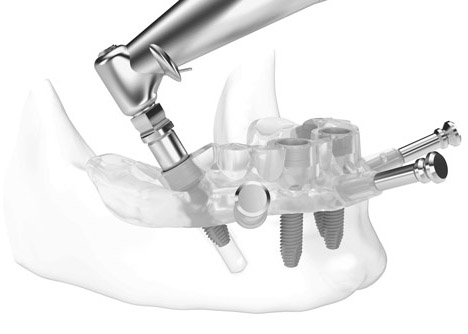Our Protocols
Guided vs. Freehand Implant Placement
Guided surgery is where the implant is placed to a particular place in the jaws using Robotic Surgery or a Surgical Guide. We use Surgical Guide Protocols. This allows us to “Pre-Position” implants precisely using digital software on a planning computer. This in turn allows us to 3-D print models of your mouth with a replica of the implant placed in the desired position. It also allows us to produce the ”Surgical Guide” with drill sleeves in place in a plastic jig which fits securely and precisely over your teeth. Using this, the drills can only go to the pre-chosen depth and position.
We can then place the implants to the desired position using the same Surgical Guide. This “Guided” Surgery protocol is more precise, safer, less invasive and faster than the traditional “Freehand” placement of implants. It’s particularly useful if we are positioning Provisional Restorations immediately following implant placement.

Bone Regeneration at the time of Implant Placement
We almost invariably place bone grafts at the time of implant placement. This fills in the voids between an extraction socket and the implant. It speeds the healing and protects the implant from contamination.
It also thickens up the gum tissues which helps the region appear more natural and makes it more resistant to infection which helps implant survival.
The case shown here demonstrates how much bone and soft tissue can be lost following the extraction of a premolar. To correct this we needed to lift back the gum tissue, then place an implant, add considerable amounts of bone graft and then place a membrane which covers over the graft.
This procedure enabled an implant to be placed while at the same time reducing the aesthetic deformity.

Immediate Vs. Delayed Implant Placement
“Immediate” implants are placed at the same time that the tooth is removed. In this protocol there would always be bone grafting and membrane placement to fill out any voids between the implant(s) and the residual bone of the extraction socket. This is needed to ensure the region regenerates as completely as possible
“Delayed” Implant placement is where the implant(s) are placed some time following the extraction. This is generally when it is certain that any infection in the region has cleared. However it does mean that the soft tissues of the region have slumped down and the bone that supported the teeth is shrinking or has shrunk away.
Generally we prefer to place implants immediately following the extraction, or shortly after. This has an advantage in that it reduces the number of surgical procedures. Instead of potentially three surgical procedures (Extraction, Implant Placement with Augmentation, Second Stage Implant Exposure), we try to achieve everything in a single surgical procedure. This can greatly reduce the overall treatment time.

Soft Tissue Placement about Implants
A good, healthy, thick collar of soft tissues surrounding an implant is important for the health and longevity of the implant. It helps prevent the onset of peri-implantitis, a condition which erodes bone support on the implant and causes it to fail. We tend to build this collar of tissue up at the time of implant placement, either by moving adjacent soft tissues in the region or by placing soft tissue autografts as these have been shown to significantly improve the long-term prognosis.

Questions
How many Surgical Procedures are needed for a dental implant?
Traditionally, a tooth was extracted and the socket was allowed to heal naturally for at least three months
By that time, much of the bone and soft tissues that surrounded the tooth have resorbed away. So most implants were placed into a resorbed ridge
Usually the implant was covered over by gum at the end of the procedure to facilitate healing. Three months later, the gum needed to be peeled back to make a connection through to the mouth
Only then could the restorative work start, and that might take several months. Three surgical procedures, at least nine months, and perhaps several months more to the final restoration
In our office, we prefer to place the implant at the time the tooth is extracted, with bone grafting to prevent bone shrinkage. 2-4 months are then required for the implant to “take” and heal fully, so then it can be restored
(One Surgical Procedure vs. Three)
What are the alternatives to Dental Implants?
Traditionally when a single tooth was lost, it was replaced with a “Flipper” which is a small plastic denture with a “Tooth” and a “Plate” which fits around the insides of the teeth adjacent to the space. This can often be loose and cause cavities and gum problems where the plate sits.
Another mode was to shave down the teeth adjacent to the lost tooth and then to place a “Fixed Bridge” with crowns on the shaved down teeth and a “Pontic” to replace the lost one. This can work well, but if one of the crowns comes loose, then the tooth underneath can decay very fast, making for a bigger problem.
Another mode is for Adhesive bridges which are bonded to the teeth on either side of the gap, but these bonds can fail and the bridge can come loose.
Dental Implants do not decay and they are anchored directly into the jawbone, so the adjacent teeth are not affected. They are stable and can support a variety of restorative options. Although expensive at the outset, their longevity, security and comfort make this the most cost effective option over the long-term.